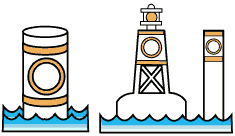Site Navigation:
Searchable Databases
Articles Archive
Pacific Nautical Heritage...
- Gallery of Light and Buoy Images
- Gallery of Mariners
- Gallery of Ship Images
- Gallery of Ship Wrecks
- Gallery of Monuments and Statues
- Gallery of Nautical Images
- Gallery of Freshwater Images
- Gallery of New Books
Canadian Naval Topics…
- Nautical History Videos
- UNTD
- British Columbia Heritage
- Arctic and Northern Nautical Heritage
- Western Canada Boat and Ship Builders
- Gallery of Arctic Images
- Reflections on Nautical Heritage
- British Columbia Heritage
Site Search:
Looking for more? Search for Articles on the Nauticapedia Site.
Special Buoys
by John MacFarlane 2016
Special buoys are used to convey specific information to the mariner. These buoys are not primarily used to assist in the navigation of the vessel. The shapes of special buoys have no significance and a variety of shapes may be used in practice. All special buoys, where lighted, will display yellow lights. With the exception of ODAS buoys, these lights will be flashing (Fl)4s, meaning that they will flash regularly at intervals of 4 seconds. Each ODAS Buoy, if lighted, will also carry yellow lights but will display a group flashing character of 5 flashes every 20 seconds, Fl(5)20s.

Pipeline Crossing Marker (Photo from the John MacFarlane collection. )
The coastal ocean bottom on the British Columbia coast is littered with oil and gas pipelines, electrical cables, telephone and cable TV services, water and sewer pipelines, sensors, tunnels and other hazards. It means you can’t anchor just anywhere. The risk is that an anchor will snag one of these structures and cause damage or death.

No Anchorage Marker (Photo from the John MacFarlane collection. )
.jpg)
The Westport I Passing a "No Anchorage Marker" (Photo from the John MacFarlane collection. )
Sometimes the signage gives no indication of the exact nature of the hazard – it just say "no anchorage".

Cautionary Buoy (Photo from the John MacFarlane collection. )
A cautionary buoy marks an area to warn mariners of nearby dangers.

Diver Down Buoy (Photo from the Google collection. )
A diving buoy is coloured white and carries a red flag not less than 50 centimetres square with a white diagonal stripe extending from the tip of the hoist to the bottom of the fly. It may display identification letter(s) and if it carries retroreflective material, such material is yellow.

A British Columbia Government buoy at the site of the wreck of the G.B. Church (Photo from the John MacFarlane collection. )
An information buoy displays, by means of words or symbols, information of interest to the mariner. An information buoy is coloured white and has an orange, open faced square symbol on two opposite sides and two orange horizontal bands, one above and one below the square symbols. The information words or symbols are black and are placed within the white face of the square symbol. It may display identification letter(s).

Control Buoy (Photo from Transport Canada. )
A control buoy marks an area where boating is restricted. A control buoy is coloured white and has an orange, open faced circle on two opposite sides and two orange horizontal bands, one above and one below the circles. A black figure or symbol inside the orange circles indicates the nature of the restriction in effect. It may display identification letter(s).

Swimming Buoy (Photo from Transport Canada. )
A swimming buoy marks the perimeter of a swimming area. A swimming buoy is coloured white, and may display identification letter(s).

Mooring Buoy (Photo from the MacFarlane collection. )
A mooring buoy is used for mooring or securing a vessel, seaplane, etc. A mooring buoy is coloured white and orange, the orange colour covering the top one third of the buoy above the waterline. It may display identification letter(s).

Private Buoy (Photo from the MacFarlane collection. )
Private Buoy Regulations apply to all private buoys placed as aids to navigation – except those used to mark fishing apparatus.
To quote from this article please cite:
MacFarlane, John M. (2016) Special Buoys. Nauticapedia.ca 2016. http://nauticapedia.ca/Gallery/Buoy_Special.php

Site News: April 13th, 2025
ANOTHER MILESTONE REACHED
The vessel database has been updated and is now holding 95,413 vessel histories (with 16,500 images and 14,326 records of ship wrecks and marine disasters).
The mariner and naval biography database has also been updated and now contains 58,599 entries (with 4,006 images).
My thanks to Ray Warren who is beginning a long process of filling gaps in the photo record of the vessel histories in the vessel database. Ray has been documenting the ships of Vancouver Harbour for more than 60 years.
Thanks to contributor Mike Rydqvist McCammon for the hundreds of photos he continues to contribute to illustrate British Columbia’s floating heritage.
My very special thanks to our volunteer IT adviser, John Eyre, who (since 2021) has modernized, simplified and improved the update process for the databases into semi–automated processes. His participation has been vital to keeping the Nauticapedia available to our netizens.
Thanks to John Spivey who is in his 4th year of fact checking all of the entries in the vessel database, one-by-one.